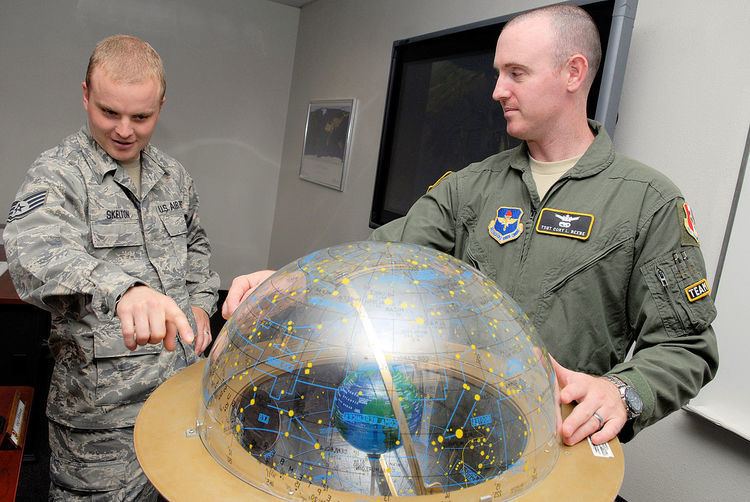Country United States | Type Squadron | |
 | ||
Active 1942-1945; 1962-1986; 1994-Present Branch United States Air Force Role Intercontinental ballistic missile Part of 381st Training Group
Air Force Global Strike Command | ||
The 533d Training Squadron is a United States Air Force unit. It is assigned to the 381st Training Group, stationed at Vandenberg Air Force Base, California.
Contents
Mission
The mission of the unit is to conduct training for the nation's space operators. It provides pipeline training for all space C2, Ground Radar Control, and spacelift maintenance technicians. It also produces thirteen career development courses in support of the nations space forces.
History
The 533d was constituted as the 533d Bombardment Squadron, Heavy on October 28, 1942, and then activated as a part of the 381st Bombardment Group, Heavy on November 3, 1942 at Gowen Field, Idaho Soon after, the 533d trained under II Bomber Command and took station at Pyote Army Air Field, Texas where the first two phases of unit training took place. The rest of the training was conducted at Pueblo Army Air Base, Colorado and in the simulations throughout the country. Received deployment orders for the European Theater of Operations (ETO) in May 1943.
During the three years before its inactivation, the 533d Bombardment Squadron was part of the rapid buildup of the Army Air Forces in the European Theater of Operations (ETO). At that time, the Eighth Air Force and the Royal Air Force Bomber Command were engaged in a combined bomber offensive against strategic targets in Nazi Germany and Occupied Europe. Armed with B-17 Flying Fortresses, the 533d was a part of many bombardment raids. These included the campaigns in Normandy, Northern France, Rhineland, Ardennes-Alsace and Central Europe. The 533d also bombed targets in support of the Battle of the Bulge.
After V-E Day, the unit returned to Sioux Falls Army Air Field, South Dakota in July 1945, although many combat personnel were demobilized upon return to the United States. A small cadre of personnel were formed with replacement personnel assigned. The unit was programmed for conversion to B-29 Superfortress very heavy bombers however no aircraft were assigned. The Japanese Capitulation in early August led to the units inactivation on 28 August, with personnel either reassigned to other units or demobilized.
Effective 20 December 1946, the squadron was activated at Offutt Field, Nebraska. Having been allotted to the organized reserves, with assignment to Second Air Force, Air Defense Command, it was redesigned as a very heavy bombardment unit on 27 December 1946. Late in September 1947, the squadron was assigned to the 381st Bombardment Group, Very Heavy. In July 1948, the group was reassigned from the Second Air Force to the Tenth Air Force, which in December, became a part of the Continental Air Command. The 533d Squadron was inactivated at Offutt Air Force Base on 27 June 1949 due to budget restrictions.
Effective 29 November 1961, the unit was redesigned the 533d Strategic Missile Squadron (ICBM-Titan), Strategic Air Command (SAC) and organized on 8 March 1962 as a part of the 381st Strategic Missile Wing. Operated nine Titan II underground silos constructed beginning in 1960; the first site going operationally ready in July 1963. The 9 missile silos remained on alert for over 20 years during the Cold War. On 27 August 1978, an accident at Site 537-7 involving an oxidizer leak killed two Air Force personnel, and caused the temporary evacuation of local communities. The damage to the site was determined to be unrepairable and 537-7 was permanently closed.
In October 1981, President Ronald Reagan announced that as part of the strategic modernization program, Titan II systems were to be retired by October 1, 1987. Inactivation of the sites began in July 1984, with the last being closed in May 1986; the squadron being inactivated on 8 August.
After removal from service, the silos had reusable equipment removed by Air Force personnel, and contractors retrieved salvageable metals before destroying the silos with explosives and filling them in. Access to the vacated control centers was blocked off. Missile sites were later sold off to private ownership after demilitarization. Today the remains of the sites are still visible in aerial imagery, in various states of use or abandonment.
Redesignated and activated on 30 September 1994 as the 533d Training Squadron, Air Education and Training Command (AETC), the 532nd serves Air Combat Command (ACC) and Air Force Global Strike Command (AFGSC) by providing initial and advanced maintenance training in LGM-30G Minuteman III, and AGM-86 ALCM air-launched cruise missile (ALCM) systems as well as spacelift maintenance training.
Lineage
Assignments
Stations
Aircraft and missiles
.* Site closed 24 Aug 1978 after an accident involving an oxidizer leak killed two Air Force personnel, caused the temporary evacuation of local communities, and damaged the site.
